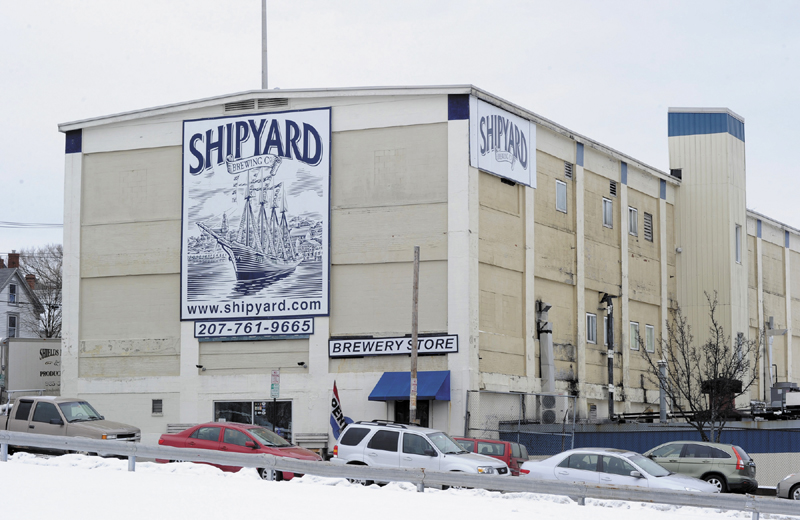PORTLAND — Contrary to what a city official said last week, Portland sewer and water officials did have experience dealing with brewery operations in 1996, when a metering mistake was made that cost the city hundreds of thousands of dollars in lost revenue from Shipyard Brewing Co.
City spokeswoman Nicole Clegg said Friday that senior wastewater technician Dave Peterson, who was in charge of setting up sewer accounts, was probably unfamiliar with brewery operations at the time because Shipyard was the city’s first brewery to operate in modern times.
Peterson, a highly regarded city employee who died in 2007, failed to set up a sewer account for Shipyard when the brewery installed a second 6-inch water line in 1996. He told a now-retired Portland Water District employee that water from the new line was going into beer bottles, not the city sewer system, according to Ron Miller, general manager at the water district. The mistake meant Shipyard was billed for only a fraction of its sewer fees over a 15-year period.
But five other breweries were already operating in Portland in 1996 – D.L. Geary Brewing Co. opened in 1986; Gritty McDuff’s in 1988; and Allagash Brewing Co., the now defunct Stone Coast Brewing Co., and Casco Bay Brewing Co. all opened in 1995.
At least one, Gritty McDuff’s, already had a separate submeter in 1996 that measured the amount of water going into beer kegs and bottles rather than into the sewer system.
Clegg said Monday that she believes Shipyard was larger than the other breweries at the time, and that may have played a role in the mistake.
She said the city needs time to complete its investigation into why no sewer account was set up for the new water line, which was installed two years after Shipyard moved to the city from Kennebunk. Still, she said, officials so far have not found an “ulterior motive” or evidence to suggest anything other than that a city employee made the wrong assumption about the amount of water entering the sewer system.
“We are still conducting the investigation,” she said. “You need to give us time to review all the files.”
Because there was no sewer account set up, the brewery never received a sewer bill for millions of gallons of water that it discharged into the city’s sewer system. The mistake meant that other city sewer users, both businesses and households, paid a larger share of the city’s sewer costs.
Shipyard, the state’s largest brewery, bottles more than 3 million gallons of beer annually. Breweries typically discharge 2 to 6 gallons of water into the sewer system for every gallon of beer produced, according to the Brewers Association, a national trade group.
The city discovered the mistake a year ago, and Shipyard has been paying its full sewer costs since March. At current production levels, the lost city revenue amounts to roughly $300,000 a year, but it would have been lower in previous years when the brewery produced less beer.
The idea of separating the water used for brewing is not new.
Representatives of Geary’s, Allagash and Gritty’s said they all have had submeters installed to measure the amount of water used in the beer they produce – rather than for cleaning equipment and other uses – in order to lower their sewer bills.
Except for an “insignificant” amount discharged into the sewer drain, all the water measured by Geary’s submeters is poured into tanks that provide the hot water for the brewing process, David Geary said. He said the submeter was installed many years ago.
Richard Pfeffer, co-owner of Gritty McDuff’s Brewing Co., said a submeter was installed when that brewery was established in 1988.
Allagash installed its submeter several years ago, said Dee Dee Germain, communications and marketing manager for the company.
Allagash, however, now uses a different system to determine its wastewater discharge. The city determines how much beer is produced from the production data the federal government uses to determine excise taxes. For the first half of 2011, Allagash received a credit of $8,400 off its sewer bill.
Allagash produces about one-third as much beer as Shipyard.
Like any brewery, Allagash uses a lot of water for processing and cleaning, Germain said.
“A fair amount of water goes down the drain,” she said.
Staff Writer Tom Bell can be contacted at 791-6369 or at: tbell@mainetoday.com
Twitter: TomBellPortland
Send questions/comments to the editors.



Success. Please wait for the page to reload. If the page does not reload within 5 seconds, please refresh the page.
Enter your email and password to access comments.
Hi, to comment on stories you must . This profile is in addition to your subscription and website login.
Already have a commenting profile? .
Invalid username/password.
Please check your email to confirm and complete your registration.
Only subscribers are eligible to post comments. Please subscribe or login first for digital access. Here’s why.
Use the form below to reset your password. When you've submitted your account email, we will send an email with a reset code.